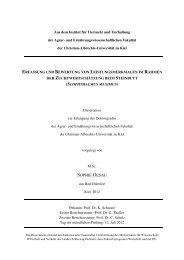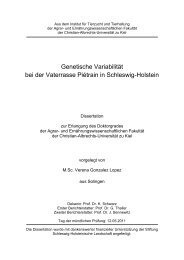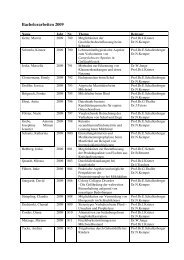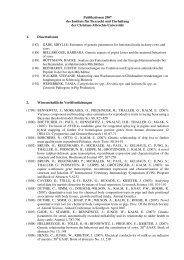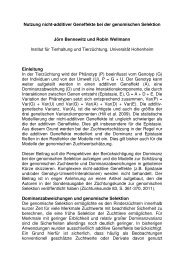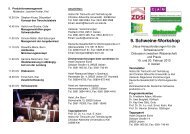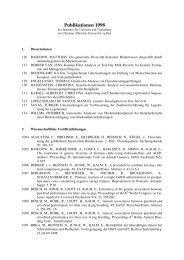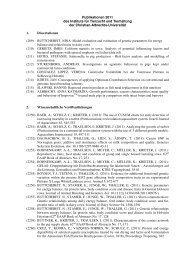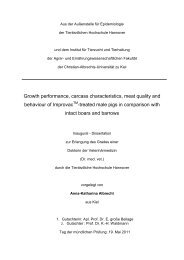Hauke Hüttmann, 2007 - Institut für Tierzucht und Tierhaltung ...
Hauke Hüttmann, 2007 - Institut für Tierzucht und Tierhaltung ...
Hauke Hüttmann, 2007 - Institut für Tierzucht und Tierhaltung ...
Sie wollen auch ein ePaper? Erhöhen Sie die Reichweite Ihrer Titel.
YUMPU macht aus Druck-PDFs automatisch weboptimierte ePaper, die Google liebt.
6 Summary<br />
6 Summary<br />
As a further development of the bull dams performance test at the dairy research farm<br />
Karkendamm the individual roughage intake has been measured since September 1, 2005<br />
utilizing a computerized scale system to estimate daily energy balances as the difference<br />
between energy intake and calculated energy requirements for lactation and maintenance.<br />
Data of 289 heifers with observations between the 11 th and 180 th day of lactation over a<br />
period of 487 days have been analyzed. Average energy corrected milk yield, feed intake, live<br />
weight and energy balance were 31.8 kg, 20.6 kg, 584 kg and 13.6 MJ NEL, respectively, per<br />
day. Fixed and random regression models have been used to find the model with the best fit<br />
<strong>und</strong>er consideration of (co)variance structures. The results of the likelihood-ratio-test show<br />
that the best model-fitting is achieved with the random regression model including the<br />
(co)variance structure Töplitz(4) for all traits. The consequences of a consideration of the<br />
(co)variance structure have been determined by a comparison of the significance of the fixed<br />
effects and the rank correlation between cow effects. As the significance levels changed for<br />
some fixed effects, they should be analyzed <strong>und</strong>er consideration of (co)variance structures,<br />
whereas the very high rank correlations between cow effects allow the estimation of genetic<br />
parameters without consideration of the (co)variance structures.<br />
The resulting genetic correlations between observations made on different lactation stages<br />
demonstrate that feed intake and energy balance at the beginning and the middle of lactation<br />
are genetically different traits. Heritability of feed intake is low with h 2 = 0.06 during the first<br />
days after parturition and increasing towards the middle of lactation, whereas the energy<br />
balance shows the highest heritability with h 2 = 0.34 until the 30 th day of lactation. Genetic<br />
correlations between energy balance and feed intake and milk yield, respectively, illustrate<br />
that energy balance depends more on the feed intake than the milk yield. Genetic correlation<br />
between body condition and energy balance decreases rapidly within the first 100 days of<br />
lactation. Since the number of animals is rather small for a genetic analysis, the genetic<br />
parameters have to be evaluated on a larger dataset.<br />
Several criteria of energy balance have been defined over different lactation stages: mean<br />
daily energy balance during the first 50 and 100 days of lactation, duration of negative energy<br />
balance, total energy deficit and minimum daily energy balance in the early stage of lactation.<br />
Residual correlations between the energy balance traits are predominantly high. Therefore, it<br />
does not seem to be necessary to define different energy balance traits.<br />
125



